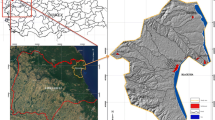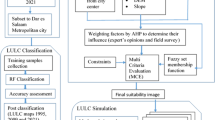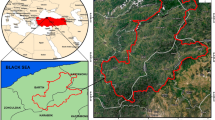Abstract
In the Himalayan states of India, with increasing population and activities, large areas of forested land are being converted into other land-use features. There is a definite cause and effect relationship between changing practice for development and changes in land use. So, an estimation of land use dynamics and a futuristic trend pattern is essential. A combination of geospatial and statistical techniques were applied to assess the present and future land use/land cover scenario of Gangtok, the subHimalayan capital of Sikkim. Multi-temporal satellite imageries of the Landsat series were used to map the changes in land use of Gangtok from 1990 to 2010. Only three major land use classes (built-up area and bare land, step cultivated area, and forest) were considered as the most dynamic land use practices of Gangtok. The conventional supervised classification, and spectral indices-based thresholding using NDVI (Normalized Difference Vegetation Index) and SAVI (Soil Adjusted Vegetation Index) were applied along with the accuracy assessments. Markov modelling was applied for prediction of land use/land cover change and was validated. SAVI provides the most accurate estimate, i.e., the difference between predicted and actual data is minimal. Finally, a combination of Markov modelling and SAVI was used to predict the probable land-use scenario in Gangtok in 2020 AD, which indicted that more forest areas will be converted for step cultivation by the year 2020.





Similar content being viewed by others
References
Alcorn J B 1993 Indigenous peoples and conservation; Conservation Biology 7 424–426.
Allen J C and Barnes D F 1985 The causes of deforestation in developing countries; Ann. Assoc. Am. Geogr. 75 163–184.
Balick M J 1990 Ethnobotany and the identification of therapeutic agents from the rainforest; In: Bioactive compounds from plants (eds) Chadwick D J and Marsh J, John Wiley & Sons, Chichester, pp. 22–31.
Bradshaw C J A, Sodhi N S, Peh K S H and Brook B W 2007 Global evidence that deforestation amplifies flood risk and severity in the developing world; Glob. Change Biol. 13 2379–2395.
Brown D G, Pijanowski B C and Duh J D 2000 Modeling the relationships between land use and land cover on private lands in the Upper Midwest, USA; J. Environ. Manag. 59 247–263.
Bruijnzeel L A 2004 Hydrological function of tropical forests: Not seeing the soil for the trees; Agriculture, Ecosystems and Environment 104 185–228.
Chakraborty M 1994 An analysis of the causes of deforestation in India; In: The causes of tropical deforestation: The economic and statistical analysis of factors giving rise to the loss of the tropical forests (eds) Brown K and Pearce D W (London: UCL Press), pp. 226–238.
Chander G and Markham B 2003 Revised Landsat-5 TM radiometric calibration procedures and post-calibration dynamic ranges; IEEE Trans. Geosci. Remote Sens. 41 2674–2677.
Chavez P S 1996 Image-based atmospheric corrections revisited and improved; Photogramm. Eng. Remote Sens. 62 1025–1036.
Chen J M 1996 Evaluation of vegetation indices and a modified simple ratio for Boreal applications; Canadian J. Remote Sens. 22 229–242.
Chen Y B, Zhou Q Y and Chen J F 2009 Spatio-temporal characteristics of land use and cover change in GuangZhou City in the past 30 years; Scientia Geographica Sinica 29(3) 368–374.
Crozier M J, Eyles R J and Wheeler R H 1978 Landslips in Wellington city; New Zealand Geographer 34 58–74.
Congalton R G 1991 A review of assessing the accuracy of classifications of remotely sensed data; Remote Sens. Environ. 37 35–46.
Dietzel C, Oguz H, Hemphill J J, Clarke K C and Gazulis N 2005 Diffusion and coalescence of the Houston Metropolitan Area: Evidence supporting a new urban theory; Environment and Planning B: Planning and Design 32 231–246.
Duggin M J and Robinove C J 1990 Assumptions implicit in remote sensing data acquisition and analysis; Int. J. Remote Sens. 11 1669–1694.
FAO 2010 Global forest resources assessment 2010: Main report; Rome, Food and Agricultural Organization, http://www.fao.org/docrep/013/i1757e/i1757e.pdf.
Glade T 2003 Landslide occurrence as a response to land use change: A review of evidence from New Zealand; Catena 51 297–314.
Guana D, Li H, Inohaec T, Su W, Nagaiec T and Hokao K 2011 Modeling urban land use change by the integration of cellular automaton and Markov model; Ecol. Model. 222 3761–3772, doi: 10.1016/j.ecolmodel.2011.09.009.
Gong P, Pu R, Biging G S and Larrieu M R 2003 Estimation of forest leaf area index using vegetation indices derived from Hyperion hyperspectral data; IEEE Trans. Geosci. Remote Sens. 41 1355–1362.
He C Y, Shi P J, Chen J and Zhou Y Y 2000 A study on landuse/cover change in Beijing area; Geogr. Res. 20(6) 679–687.
Herold M, Goldstein N C and Clarke K C 2003 The spatiotemporal form of urban growth: Measurement, analysis and modelling; Remote Sens. Environ. 86(3) 286–302.
Huete A R 1988 A soil-adjusted vegetation index (SAVI); Remote Sens. Environ. 25 295–309.
Huete A R, Liu H Q, Batchily K and van Leeuwen W 1997 A comparison of vegetation indices over a global set of TM images for EOS-MODIS; Remote Sens. Environ. 59 440–451.
Jackson R D and Huete A R 1991 Interpreting vegetation indices; Preventive Veterinary Medicine 11 185–200.
Landis J R and Koch G G 1977 The measurement of observer agreement for categorical data; In: Biometrics, 33.
Laurance W F 1999a Gaia’s lungs: Are the rainforests inhaling earth’s excess carbon dioxide?; Natural History 108 96.
Laurance W F 1999b Reflections on the tropical deforestation crisis; Biological Conservation 91 109–117.
Liu H and Zhou Q 2005 Establishing a multivariate spatial model for urban growth prediction using multi-temporal images; Computers, Environment and Urban Systems 29(5) 580–594.
Masek J G, Lindsa F E and Goward S N 2000 Dynamics of urban growth in the Washington DC metropolitan area, 1973–1996, from Landsat observations; Int. J. Remote Sens. 21 3473–3486.
Melesse A M 2004 Spatiotemporal dynamics of land surface parameters in the Red River of North Basin; Physics and Chemistry of the Earth A/B/C 29 795–810.
Miller R B and Small C 2003 Cities from space: Potential applications of remote sensing in urban environmental research and policy; Environmental Science & Policy 6 129–137.
Moghadam H S and Helbich M 2013 Spatiotemporal urbanization processes in the megacity of Mumbai, India: A Markov chains-cellular automata urban growth model; Appl. Geogr. 40 140e149, doi: 10.1016/j.apgeog.2013.01.009.
Mollicone D, Achard F, Federici F, Eva H D, Grassi G, Belward A, Raes F, Swufert G, Stibig H-J, Matteucci G and Schulze E-D 2007 An incentive mechanism for reducing emissions from conversion of intact and non-intact forests; Climatic Change 83 477–493.
Muller R M and Middleton J 1994 A Markov model of land-use change dynamics in the Niagara region, Ontario, Canada; Landscape Ecology 9 151–157.
Myers N 1994 Tropical deforestation: Rates and patterns; In: The causes of tropical deforestation: The economic and statistical analysis of factors giving rise to the loss of the tropical forests (eds) Brown K and Pearce D W (London: UCL Press), pp. 27–40.
O’Loughlin C L and Pearce A J 1976 Influence of Cenozoic geology on mass movement and sediment yield response to forest removal, north Westland, New Zealand; Bull. Int. Assoc. Eng. Geo. 14 41–46.
Page M J and Trustrum N A 1997 A late Holocene lake sediment record of the erosion response to land use change in a steepland catchment, New Zealand; Zeitschrift für Geomorphologie N.F. 41 369–392.
Page M J, Trustrum N A and Dymond J R 1994a Sediment budget to assess the geomorphic agent of a cyclonic storm, New Zealand; Geomorphology 9 169–188.
Page M J, Trustrum N A and DeRose R C 1994b A high resolution record of storm induced erosion from lake sediments, New Zealand; J. Palaeolimnol. 11 333–348.
Pal M and Mather P M 2004 Assessment of the effectiveness of support vector machines for hyperspectral data; Future Generation Computer Systems 20(7) 1215–1225.
Peterson L K, Bergen K M, Brown D G, Vashchuk L and Blam Y 2009 Forested land-cover patterns and trends over changing forest management eras in the Siberian Baikal region; Forest Ecol. Manag. 257 911–922.
Phillips O L, Malhi Y, Higuchi N, Laurance W F, Nunez P, Vasquez R, Laurance S, Ferreira L, Stern M, Brown S and Grace J 1998 Changes in the carbon balance of tropical forests: Evidence from long-term plots; Science 282 439–442.
Robinson V B 1978 Information theory and sequences of land use: an application; The Professional Geographer 30 174–179.
Rouse J W Jr, Haas R H, Shell J A and Deering D W 1974 Monitoring vegetation systems in the Great Plains with ERTS; In: Third Earth Resources Technology Satellite-1 Symposium, 10–14 December 1973, Vol. 1, Washington D.C., pp. 309–317.
Smits P C, Dellepiane S G and Schowengerdt R A 1999 Quality assessment of image classification algorithms for land-cover mapping: A review and a proposal for a costbased approach; Int. J. Remote Sens. 20 1461–1486.
Sobrino J A, Jimenez-Munoz J C and Paolini L 2004 Land surface temperature retrieval from LANDSAT TM 5; Remote Sens. Environ. 90 434–440.
Song C, Woodcock C E, Seto K C, Pax-Lenney M and Macomber S A 2001 Classification and change detection using Landsat TM data; Remote Sens. Environ. 77 241–246.
Story M and Congalton R 1986 Accuracy assessment: A user’s perspective; Photogramm. Eng. Remote Sens. 52 397–399.
Tang J, Wang L and Yao Z 2007 Spatio-temporal urban landscape change analysis using the Markov chain model and a modified genetic algorithm; Int. J. Remote Sens. 28(15) 3255–3271, doi: 10.1080/01431160600962749.
Voogt J A and Oke T R 2003 Thermal remote sensing of urban climates; Remote Sens. Environ. 86 370–384.
Weng Q 2002 Land use change analysis in the Zhujiang delta of China using satellite remote sensing, GIS and stochastic modelling; J. Environ. Manag. 64 273–284.
Wu Q, Li H, Wang R, Paulussen J, Hec Y, Wang M, Wang B and Wang Z 2006 Monitoring and predicting land use change in Beijing using remote sensing and GIS; Landscape and Urban Planning 78 322–333.
Zhang X, Yan G, Li Q, Li Z-L, Wan H and Guo Z 2006 Evaluating the fraction of vegetation cover based on NDVI spatial scale correction model; Int. J. Remote Sens. 27 5359–5372.
Zhang Q, Wang J, Peng X, Gong P and Shi P 2002 Urban built-up land change detection with road density and spectral information from multi-temporal Landsat TM data; Int. J. Remote Sens. 23(15) 3057–3078.
Zhang X, Kang T, Wang H and Sun Y 2010 Analysis on spatial structure of landuse change based on remote sensing and geographical information system; Int. J. Appl. Earth Observation Geoinform. 12S S145–S150.
Zhou Q and Hou Q 2009 The broad landuse pattern and landuse change in the last two decades; In: Hong Kong, Macau and the Pearl River Delta: A Geographical Survey (ed.) Wong K K, Hong Kong Educational Publishing Co., Hong Kong, pp. 68–98.
Zhao Y 2003 Principles and Methods for Remote Sensing: Applications and Analysis; Science Press, Beijing.
Author information
Authors and Affiliations
Corresponding author
Rights and permissions
About this article
Cite this article
Mukhopadhyay, A., Mondal, A., Mukherjee, S. et al. Forest cover change prediction using hybrid methodology of geoinformatics and Markov chain model: A case study on sub-Himalayan town Gangtok, India. J Earth Syst Sci 123, 1349–1360 (2014). https://doi.org/10.1007/s12040-014-0476-2
Received:
Revised:
Accepted:
Published:
Issue Date:
DOI: https://doi.org/10.1007/s12040-014-0476-2




